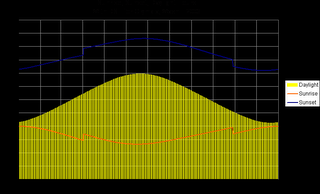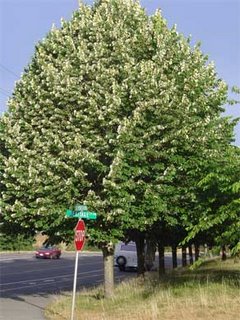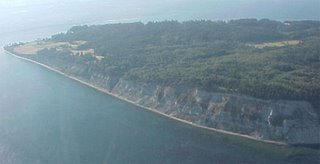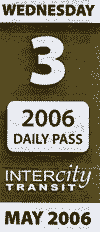





Mr. Jenner's banking career led to a four-year posting in Hong Kong for the National Bank of Commerce in 1967, and Jo worked as a volunteer for several years with the Family Planning Council there. Her creation of a promotional poster featuring a pregnant man earned international media attention.I hope that I am as creative, connected, and committed as Jo was when I’m her age. We’ll miss you, Jo.
When we heard how people were going to be stuck, some of us got together and organized the Oly Free Bus. We used our own vehicles on our own time paying for gas with our own money, and we tried to fill the gaps in transit service as best we could. At the time, I had a van equipped with a wheelchair lift, and I'm proud to say that for 13 weeks in the spring of 2000, my van was the only wheelchair accessible public transportation in Thurston County on Sundays. At first we tried running scheduled routes, to make our service as much as possible like what people had come to expect from IT. After a few weeks, we got enough publicity and enough public support that we were able to switch to more of an on-call service. A local business owner paid for us to have cell phones, and helped to pay for gas.This is an example of the idealism and bias for action that I love about this town. Of course, no good deed goes unpunished, so the rest of the story involves a letter from an attorney, working for -- you guessed it -- Intercity Transit. I can't wait for Part Two.
A former Thurston County paralegal secretary has filed an $86,000 sexual- and disability- discrimination and retaliation claim against the county and the office of Prosecuting Attorney Ed Holm.Following this item from a few months back...
Holm, who could not be reached for comment late Friday, was not specifically named in the claim, which was filed Jan. 9 with the county's human resources department by Susanne Davis of Lacey. Davis, who worked for about 14 years in the county's non-support office, left her job in fall 2004 on disability and was fired in 2005, said her attorney, William Michael Hanbey of Olympia.
SHELTON - The Thurston County Prosecuting Attorney's Office discriminated against three of its former attorneys because they are women, and the county now owes them $1.52 million in damages, a Mason County jury decided Tuesday....brings to mind questions about the competence of the Prosecutor. I don't care how good an attorney he is, if the shop he runs can't avoid these kinds of problems, then he's not the manager that the job calls for.
The jury also found that the Prosecuting Attorney's Office retaliated against each of the three plaintiffs after they came forward with their discrimination complaints.
wastewater management and reclaimed water production services for the urbanized area of north Thurston County, Washington. Its four government partners (Lacey, Olympia, Tumwater and Thurston County) jointly provide programs and facilities serving a 23,000 acre area and more than 85,000 people. The LOTT system currently includes a central Treatment Plant (the Budd Inlet Treatment Plant), the Budd Inlet Reclaimed Water Facility, major “interceptor” sewer lines, and three pump stations. Services include flow management, long-range planning, financing, and design and construction of capital facilities. A Reclaimed Water Satellite Plant is currently under construction.I have always lived in an area served by sewers, rather than septic systems or some other, more primitive methods, though I recently realized that my family’s house on Whidbey Island has a septic tank. It makes it easy to ignore what happens when I flush.




Believe me, my young friend, there is NOTHING--absolute nothing--half so much worth doing as simply messing about in boats.I spent a couple of hours on Percival Landing at the Wooden Boat Fair this afternoon. For several reasons, I don’t get down there very often, so I was glad to have the chance this weekend – and that the weather was as nice as it was. (It isn’t always nice at all, this time of year.)The Water Rat, Wind in the Willows

The second is the cutest tug I've ever seen. It's only 14 feet long.
 Thumbs up! I rode to work again today and then downtown for a little after work socializing and then back up the hill to home; all without a hitch. Once I was past the anxiety of missing the bus, I found it less effort than driving (and certainly less than walking).
Thumbs up! I rode to work again today and then downtown for a little after work socializing and then back up the hill to home; all without a hitch. Once I was past the anxiety of missing the bus, I found it less effort than driving (and certainly less than walking).